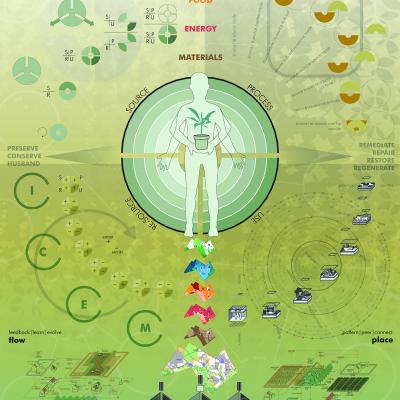EcoBalance
EcoBalance is a design and planning tool which seeks equilibrium between the human and natural environments by identifying and quantifying key life support systems (Air, Water, Food, Energy and Materials) and Life Cycle Principles (Source, Process, Use and Re- Source). EcoBalance recognizes that a circular economy as well aslife cycle behavior is critical to green design.
The related procedures of ecoBalance Planning and Design address first order spatial areas using the five life cycle stages: source, transport, manufacture, use, re-source. These can be tracked during any scale of site development and building design. EcoBalance is fundamentally aligned with the all-important word cycle within the phrase “life cycle”. It ameliorates impact within different scalar boundaries — from home to community — by actually including the steps (and areas) necessary to balance a particular resource use: air, water, energy, materials, and food. EcoBalance operates at any scale taking into account the eco-technology including the area that the technology takes up as land area support systems. EcoBalance draws from Permaculture and procedures expounded by ZERI, the Zero Emissions Research Institute. We have used ecoBalance at many scales, from communities comprised of five families to towns of 20,000 people.
FUNDING:
The Educational Foundation of America
PROJECT TEAM:
Pliny Fisk III; Rich MacMath; John Motloch; Fabien Prouvost; Rodolpho Ramina
03

